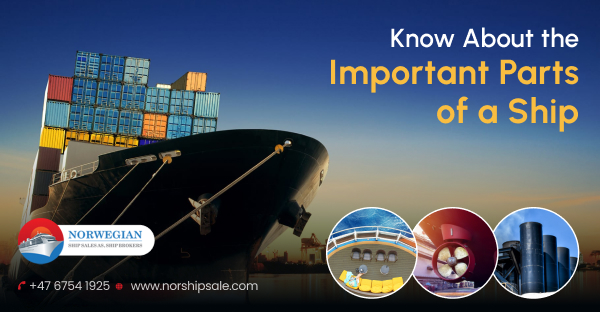A ship is made up of several parts. While it is not difficult to imagine that a ship is made of many parts, many of us are not aware of its function. To understand a ship’s quality and efficiency, it is essential to know about the different parts it is made of and the role they play in the ship’s operation. The three important parts that we cannot imagine a ship without are- the engine room, the Hull and a navigation bridge. There are many other parts of the ships. As you are planning to buy the best ferries for sale, here you can take a look at some of the common and important parts of a vessel.

Flying Bridge
Flying bridge is the extended part on the top of the weather deck of a vessel. This area offers an unobstructed view of the forward, backward and sides of the ship to navigational officers. This also works as an operating station for the officer and crew of the watch. Plus, it also contains duplicate control sets that are vital for ship officers and captains for berthing and unberthing the ship.
Bridge
The bridge on the ship works as its commanding station. It helps to control the ship’s movement with the help of navigational equipment. Further, with the help of the bridge, deck machines and the main engine are also controlled. Additionally, the functions conducted on the ship’s bridge are the ship’s direction, and speed, sea conditions and weather are monitored, fixing and navigating the ship’s position, and also, internal and external communications are conducted.
Accommodation
The accommodation part of the vessel is where the crews live. It is an essential part of the vessel as it consists of garbage disposal, sewage and freshwater systems. This is also the space that allows crews to relax, and get medical facilities etc.
Funnel
Funnel on the ship’s chimney that helps to discharge the boiler’s smoke. The funnel helps to lift the released gasses and remove them from the area around the deck.
Decks
On the ship, there are multiple decks and deck sections. The deck on the top is known as the weather or the main or the primary deck and the other’s decks are the upper deck, lower, foredeck and weather deck. The deck floor covers the structure of the hull.
Mast
Mast on a ship has several functions on the ship such as carrying derricks, allowing navigation light, radio, and salient yards to be lifted to a proper height. This is possible because the mast itself is elevated vertically to the ship’s center line.
Bulbous Bow
A Bulbous Bow is like a bulb that stays jut out at the vessel’s bow just underneath W/L. This helps to navigate through the water by tweaking the flow of water surrounding the hull. It also aids in increasing the speed of the ship, and helps to keep the ship stable and maintains fuel efficiency.
Stern
The ship’s stern is a structure that is at the rearmost part of your vessel, which helps to minimise resistance, works of preventing vibrations and increases propulsion efficiency. As it is at the back it also helps to prevent the water from entering. It can be flat shaped, tapered, sharp and of many shapes.
Rudder
Rudder helps to steer the ship, which is a very important function as it helps the ship to move in the determined direction.
Propeller
Now, propeller is a mechanical equipment that has blades attached to its central shaft. As these rotate the rotational energy gets converted to pressure and therefore the propeller provides a thrust for the propulsion.
Planning to buy a ferry for sale? Then make sure to contact a good shipbroker.
Hull
The hull is a watertight vessel’s body. It can be partially covered with a deck or open. The hull of the ship consists of many watertight decks and bulkheads as it is the major transverse membrane. The intermediate hull consists of webs, stringers and girders.
Side Thrusters
Side thrusters are similar to propellers that are fitted on two sides of a ship’s bow. The side thrusters help to change the ship’s direction at a minimal speed in an area that is congested such as neat ports.
Ballast Tanks
Ballast tanks of a vessel help to stabilize the vessels. These are compartments that are designed to carry water.
Conclusion
There are many other parts of the ship, however, in this blog, we have narrowed it down to some of the most important parts of a ship and have mentioned their functions in details. So, should you be someone who wants to buy a ferry for sale, hopefully can now understand what to expect from different ship components and buy the best model.

